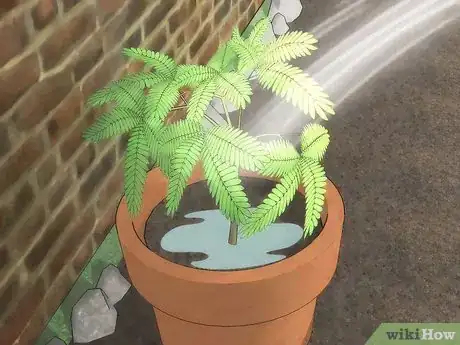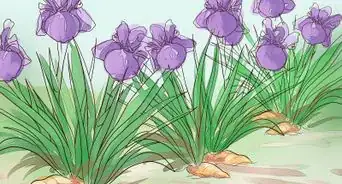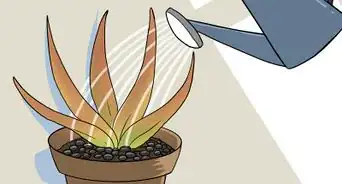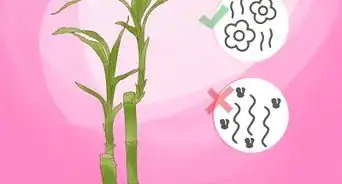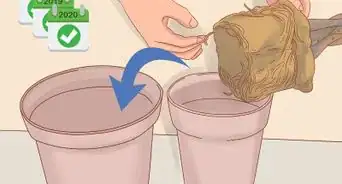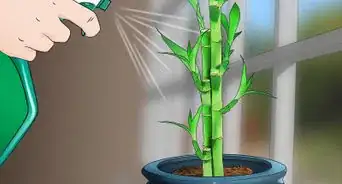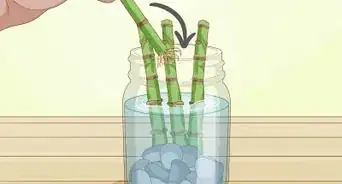This article was co-authored by Lauren Kurtz. Lauren Kurtz is a Naturalist and Horticultural Specialist. Lauren has worked for Aurora, Colorado managing the Water-Wise Garden at Aurora Municipal Center for the Water Conservation Department. She earned a BA in Environmental and Sustainability Studies from Western Michigan University in 2014.
wikiHow marks an article as reader-approved once it receives enough positive feedback. In this case, 94% of readers who voted found the article helpful, earning it our reader-approved status.
This article has been viewed 290,677 times.
Have you ever seen a plant that moves when you tickle it? Mimosa pudica, also known as a sensitive plant, TickleMe Plant, touch-me-not, or shy plant, folds its leaves together when you touch it. Unlike most other fast-moving plants, this plant is not carnivorous. Growing sensitive plants is fairly easy if you start with a warm indoor space and plenty of seeds. Be careful: even though this is a tropical plant, it can invade gardens and fields in much cooler climates.
Steps
Planting Mimosa Pudica
-
1Choose a planting time. Plant Mimosa pudica seeds indoors in spring, at any time before the last frost.[1] If you have growing lights and good temperature control, you may plant them indoors at any time of year.
-
2Purchase some seeds from a reputable grower. Take off the brown outer covering. Then you will have a greenish seed.
- Scratch the surface of the seed to scarify it. Tweezers have worked well for this part, though it may be hard.
Advertisement -
3Prepare your potting mix. Mimosa pudica can grow in most well-drained soil. For best results, however, try a mix of loam and dry, aerating materials, such as two parts loam, two parts peat moss, and one part sand or perlite.[2] If you don't want to make your own mix, most all-purpose commercial potting mixes have similar ratios, and should work well enough.
-
4Soak the seeds (optional). The seeds are more likely to germinate if you weaken the tough outer seed coat first. Soak the seeds in bowl of water for up to 24 hours if you want to play it safe.[3] (You may let the water cool as the seeds soak.)
-
5Plant two or three seeds in each small flower pot. Place each seed just barely below the surface of the soil, about 3mm (⅛ in.) down.[4] It's likely that most of your seeds won't germinate, so these extra seeds will minimize wasted effort.
- You can start the seeds in a seed tray or in 7 centimeter (2.8 in) (3 in.) pots.[5]
-
6Water the soil. Water until the soil is slightly moist, but not soggy. Water again whenever the soil is about to dry out.[6]
- If you're worried about getting the right amount of water, place the flowerpot in a shallow dish of water. Let sit ten minutes or until the top of the soil feels damp, then discard the excess water.[7]
-
7Provide plenty of sunlight. If sensitive plants do not get enough sun, they may close their leaves. Put them in a location where they receive full sun for most of the day, or partial shade if you live in a very hot region. In ideal conditions with temperatures around 70ºF (21ºC), the seeds may germinate in under a week. In less ideal conditions, or if you didn't soak the seeds, this may take two to four weeks.[8]
- Some of your seeds may survive colder nighttime temperatures, but they may end up slow-growing or fragile. Never expose the seeds to frost.
- If the room is too cool or too dry, cover the pot with plastic wrap to trap heat and moisture. Remove this as soon as the first seedling appears.
Propagating a Mimosa Pudica
-
1Cut a 4 inch (10 cm) shoot from a mature sensitive plant. You can plant the shoot and grow a new sensitive plant from it. Make sure the shoot you cut has at least one leaf node on it.
-
2Plant the shoot in a pot using a peat moss and perlite potting mixture. To plant the shoot, dig a small hole in the potting mixture and place the root-end of the shoot in it. Then, fill in the hole.
- If you want the shoot to grow roots before you pot it, put it in a glass of water after you cut it and set it in a sunny location. Once the roots start to form, transfer the shoot to a pot.
-
3Cover the top of the pot with plastic wrap. The plastic wrap will create a humid environment for the shoot to get established in.
-
4Keep the soil moist until the shoot gets established. Check on the soil daily to make sure it isn't dry. If
Caring for the Plant
-
1Transplant to other pots when necessary. If more than one seedling sprouts in the same pot, then snip the weakest seedlings with scissors. This will make room for the healthiest seedling. You can also transplant all of the seedlings into separate containers, but keep in mind that this is riskier. Once your plant reaches maturity, transplant it to a larger pot whenever the roots come out the drainage hole or press against the sides of the container.
-
2
-
3Keep the plant indoors (recommended). Sensitive plants are an invasive weed in many areas. Unless you are in one of their native habitats in tropical America, you may want to grow sensitive plants indoors. Gardeners worldwide report the plant taking over their lawns.[11]
- In Australia, you are legally required to minimize the spread of mimosa pudica seeds off your property.
-
4Fertilize regularly. Dilute a balanced fertilizer to half the strength recommended on the label. Apply to the soil once a week during the growing season, and once a month during winter.[12]
-
5Protect against cold. Since it is a tropical plant, Mimosa pudica will grow best if nighttime temperatures are 70ºF (21ºC) or higher.[13] If temperatures fall below 65ºF (18ºC), move the plant to a warmer room or keep the plant warm in other ways.[14]
- Adult plants can survive temperatures as low as 40ºF (4.5 °C), but are at risk of damage or death. Keep an eye out for yellow leaves and stems, which are signs of possible cold damage.[15]
-
6Provide space for the plant to grow. It's normal for the stem to fall over and creep along the ground once the plant matures. Provide a trellis or sturdy plant to support it, or allow enough horizontal space for it to grow. Some sensitive plants grow more than 1 meter (3 ft) high or 2 meters (6.6 ft) horizontally, but in temperate zones they will more likely reach half this size.
-
7Watch its lifespan. Mimosa pudica can survive for at least two years in tropical climates, but are usually annual plants in temperate zones.[16] Even if your plant survives after its first bloom (usually in summer), you may have better results letting it die and collecting its seeds for next spring.
- To collect seeds, let the pods dry on the plant, then break them open and collect the seeds.[17]
-
8Prevent disease. The sensitive plant is not particularly prone to disease, but it may become infested with some common pests, such as red spider mites, mealy bugs, and thrips. These can be removed by spraying the plant with a direct stream of water or neem oil every few days.
- Avoid using insecticidal soaps, as these can turn the leaves of the plant black.
Expert Q&A
Did you know you can get expert answers for this article?
Unlock expert answers by supporting wikiHow
-
QuestionHow should I plant a Mimossa tree that has few roots?
 Lauren KurtzLauren Kurtz is a Naturalist and Horticultural Specialist. Lauren has worked for Aurora, Colorado managing the Water-Wise Garden at Aurora Municipal Center for the Water Conservation Department. She earned a BA in Environmental and Sustainability Studies from Western Michigan University in 2014.
Lauren KurtzLauren Kurtz is a Naturalist and Horticultural Specialist. Lauren has worked for Aurora, Colorado managing the Water-Wise Garden at Aurora Municipal Center for the Water Conservation Department. She earned a BA in Environmental and Sustainability Studies from Western Michigan University in 2014.
Professional Gardener A mimossa tree is not the same as Mimosa pudica, which is discussed in this article. You should plant your tree as you would plant any other tree. Keep in mind that some plants will be able to grow more roots quickly enough to survive transplant, while others won't. Always keep the plant watered and fertilize with a balanced fertilizer.
A mimossa tree is not the same as Mimosa pudica, which is discussed in this article. You should plant your tree as you would plant any other tree. Keep in mind that some plants will be able to grow more roots quickly enough to survive transplant, while others won't. Always keep the plant watered and fertilize with a balanced fertilizer. -
QuestionHow hot should the water be?
 Lauren KurtzLauren Kurtz is a Naturalist and Horticultural Specialist. Lauren has worked for Aurora, Colorado managing the Water-Wise Garden at Aurora Municipal Center for the Water Conservation Department. She earned a BA in Environmental and Sustainability Studies from Western Michigan University in 2014.
Lauren KurtzLauren Kurtz is a Naturalist and Horticultural Specialist. Lauren has worked for Aurora, Colorado managing the Water-Wise Garden at Aurora Municipal Center for the Water Conservation Department. She earned a BA in Environmental and Sustainability Studies from Western Michigan University in 2014.
Professional Gardener
-
QuestionHow long does it take Mimosa pudica to grow?
 Community AnswerAfter germinating in spring, sensitive plants usually grow to maturity over the next few months, flowering in summer. The growth speed can vary greatly based on your climate. The plant may survive for a second year of growth in tropical regions, but the growth rate usually slows.
Community AnswerAfter germinating in spring, sensitive plants usually grow to maturity over the next few months, flowering in summer. The growth speed can vary greatly based on your climate. The plant may survive for a second year of growth in tropical regions, but the growth rate usually slows.
Warnings
- Several types of insects feed on Mimosa pudica, and soap sprays — a common all-purpose treatment — may blacken the plant's leaves. This is another good reason to keep the plant indoors and away from any infected plants.⧼thumbs_response⧽
- Experts consider Mimosa pudica safe to grow around pets and children.[18] However, the plant could theoretically cause health issues if eaten in large quantities. Most plants also have small thorns which are painful to touch.⧼thumbs_response⧽
- Mimosa pudica is a noxious weed in countries such as Australia and New Zealand. Extreme care should be taken in Australia and New Zealand to ensure that all plant material is contained within your property, and when pruning, discard all matter responsibly to prevent inadvertent release into the local environment.⧼thumbs_response⧽
References
- ↑ http://davesgarden.com/guides/pf/go/2573
- ↑ http://www.plantoftheweek.org/week147.shtml
- ↑ https://books.google.com/books?id=raB2KfE5SmcC
- ↑ https://books.google.com/books?id=raB2KfE5SmcC
- ↑ http://www.seedaholic.com/mimosa-pudica-the-sensitive-plant.html
- ↑ http://www.plantoftheweek.org/week147.shtml
- ↑ https://books.google.com/books?id=raB2KfE5SmcC
- ↑ http://www.plantoftheweek.org/week147.shtml
- ↑ http://www.plantoftheweek.org/week147.shtml
- ↑ http://www.seedaholic.com/mimosa-pudica-the-sensitive-plant.html
- ↑ http://davesgarden.com/guides/pf/go/2573
- ↑ http://www.plantoftheweek.org/week147.shtml
- ↑ http://www.seedaholic.com/mimosa-pudica-the-sensitive-plant.html
- ↑ http://www.plantoftheweek.org/week147.shtml
- ↑ http://davesgarden.com/guides/pf/go/2573
- ↑ http://www.seedaholic.com/mimosa-pudica-the-sensitive-plant.html
- ↑ http://davesgarden.com/guides/pf/go/2573
- ↑ https://ucanr.edu/sites/poisonous_safe_plants/files/154528.pdf
About This Article
Mimosa pudica, commonly known as a sensitive plant, is a beautiful plant that folds its leaves in when you touch it. To grow a sensitive plant, first you'll need plant some sensitive plant seeds in a small flower pot. Keep the pot in an indoor room that gets plenty of sunlight, and water the soil whenever it starts to dry out so it's always damp. As your plants grow, transplant it to a new pot when the roots push against the side of the pot or start coming out through the drainage holes. Since sensitive plants are native to a tropical climate, keep your plant in a room that’s never colder than 65 degrees Fahrenheit. For tips from our Gardening co-author on how to fertilize your sensitive plant, keep reading!
-Step-1.webp)
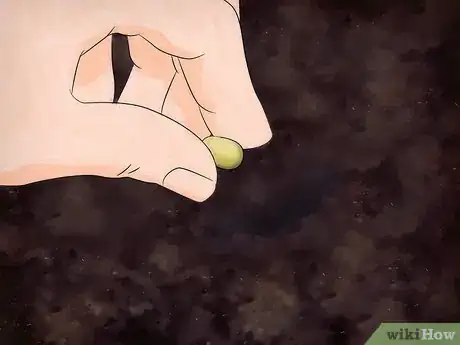
-Step-2.webp)
-Step-3.webp)
-Step-4.webp)
-Step-5.webp)
-Step-6.webp)
-Step-8-Version-2.webp)
-Step-9-Version-2.webp)
-Step-10-Version-2.webp)
-Step-11-Version-2.webp)
-Step-7.webp)
-Step-8.webp)
-Step-9.webp)
-Step-10.webp)
-Step-11.webp)
-Step-12.webp)
-Step-13.webp)
